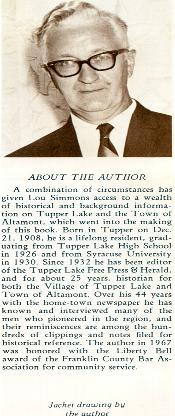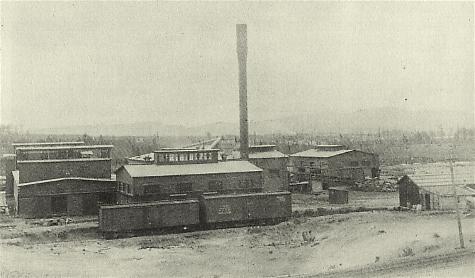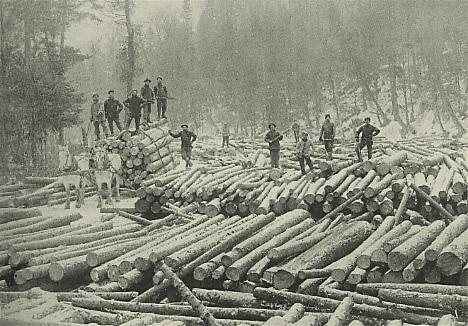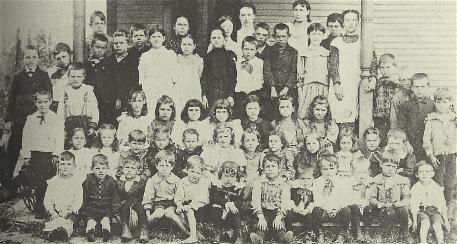TUPPER LAKE, NY
For those of us who grew up Bashant, the Tupper Lake region was important geography. Summer trips, first by train and later by car, became an annual ritual that was much anticipated. Gramma Bashant had a real batch grandchildren, but she made each one of us feel special. I remember her bacon and eggs every morning, and burning my fingers as I turned the bread to toast each side on the old fashioned toaster.
The following is a series of photographs I scanned from the book, “Mostly Spruce and Hemlock”, by Louis Simmons. Mr. Simmons grew up in Tupper Lake and was the editor of the Tupper Lake Free Press & Herald for 25 years. Penned on the inside cover sheet is the acknowledgment, “To Gordon Bashant, with whom the author shared the swimming hole a good many years ago. . . Lou Simmons”.
Mr. Simmons stands near my father in what was described as the only school photo taken of the entire Tupper Lake High School student body at the same time. (This class picture, not included here, was a copy of the panoramic view taken fifty years earlier, and covered the top of pages two and three of the Free Press and Herald for September 20, 1972. My scanner just wasn’t up to the job of reproducing it.)



In his book, Mr. Simmons describes various aspects life in and around Tupper Lake, highlighted by many photos. Those I’ve chosen give me the opportunity to show you Tupper Lake through my own eyes. Certainly most were taken before I was born, but that doesn’t detract from the charm I experienced in Tupper from the late 40’s into adulthood. Many Bashant offspring who read this will have made the same trips to Tupper as children – and, of course, will have taken their own unique set of memories from the experience.

Brooklyn Cooperage
New York State legislation allowed Cornell University to establish a school of Forestry by acquiring some 30,000 acres of timberland near Tupper. When an experiment in partial cutting caused the deforestation of a good portion of woodland, the resultant availability of so much precut timber encouraged Brooklyn Cooperage to set up a barrel stave business in Tupper Lake. My great grandfather Levi, and grandfather Solomon worked at the Cooperage at various times in their careers. My father, Gordon, Solomon’s oldest son, spoke of summer projects when he was one of the young students enlisted to plant seedlings in the denuded mountains. I remember during car trips up to Tupper, Dad would point out sections of forest between Blue Mountain Lake and Tupper Lake where differences in new and old growth were obvious. “New” trees, planted nearly thirty years earlier, were lined up in neat, orderly rows, in stark contrast to the natural blending of the older growth.

Lumbering
Lumbering was an important part of the area’s economy. Mr. Simmons names many lumber companies that prospered there, taking advantage of the French Canadian labor pool drawn to Clinton and Franklin counties. Adelard LaBounty [Gramma Bashant’s father] was one such lumberjack. Grandpa LaBounty handled the teams of horses used to pull cut lumber out to the rivers. He was known to have had powerful arms and hands. Grandpa LaBounty is pictured on the Bashant Page; notice his hands. I suspect he must certainly have suffered from arthritis.

Station at Junction
The train station at Tupper Lake Junction looks like a commuter station in any busy suburb today. During the heyday of Tupper Lake’s economic lumber boom there were many businesses that grew up around logging, the associated manufacturing, and summer resort activities. Notice the handwritten description, “NYC Station, Faust, NY”. The wife of Tupper Lake Junction’s first postmaster was chosen by lot to name the post office. She settled on Goethe’s Faust, the main character of an operetta popular at that time. Although the original plan was only to name the post office to distinguish it from Tupper Lake’s uptown post office, all of the downtown area became known as Faust, NY.
The train station served as our means into Tupper Lake until the drive from Utica became more practical, but in the late 40’s and early 50’s we went by train. The north – south tracks ran parallel to Washington Street, where at number 43 Grandpa and Gramma Bashant raised their 11 children in a three bedroom rented house that was too small to do the job. My father described sleeping arrangements for the eight boys as “in shifts” and “we slept lined up across the same bed”.
I remember the grassy, overgrown field that separated the tracks from Washington St. Carrying our suitcases, we would cross the tracks and the narrow field to get to the old homestead, regardless of weather. It was always an adventure at the end of an exciting train trip.
NYCRR Adirondack Division

First Class
Simmons’ book describes some of the schools that educated the children of Faust. This class photo of the original grammar school was taken in the late 1800’s. Ella LaBounty [Gramma Bashant] is just left of center, third row from the bottom and can be identified by her dark hair, bangs and serious expression. ( I remember her as always smiling.)
"Mostly Spruce and Hemlock", Louis Simmons, Tupper Lake, New York, Copyright 1976, Printed by Vail-Ballou Press, Inc.

